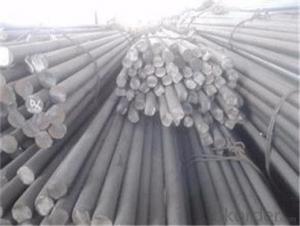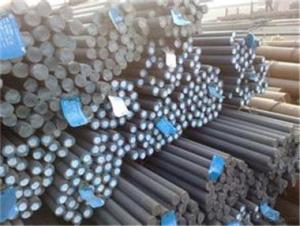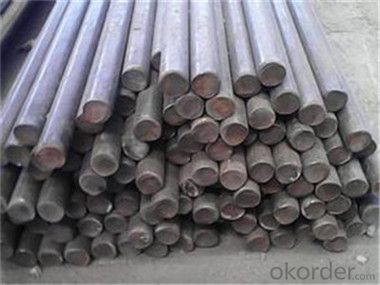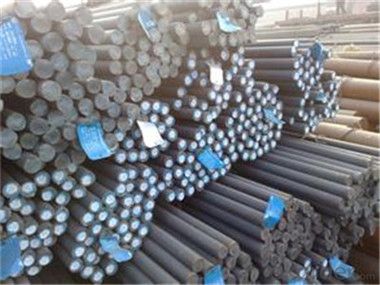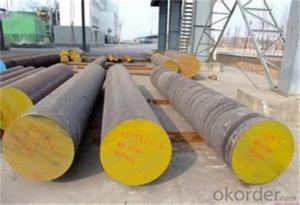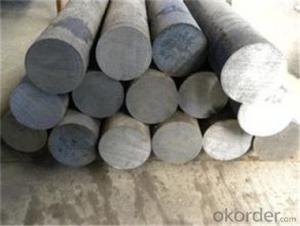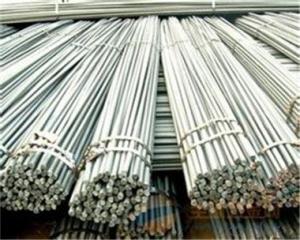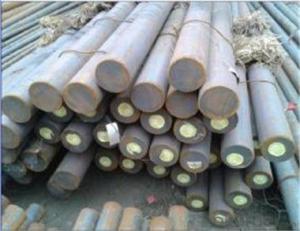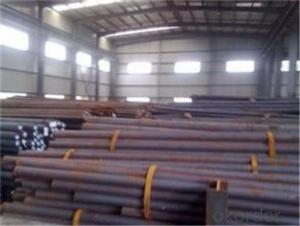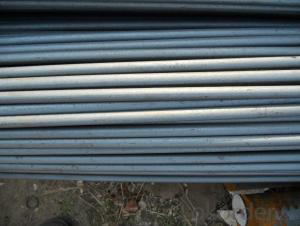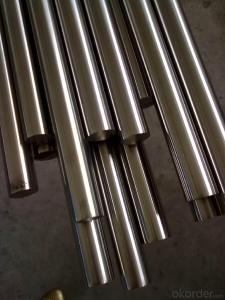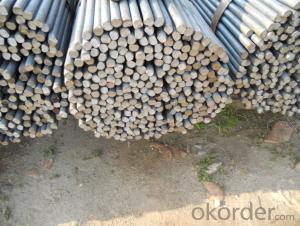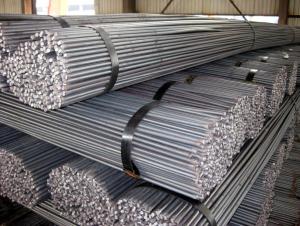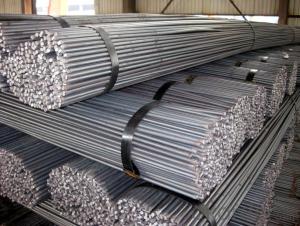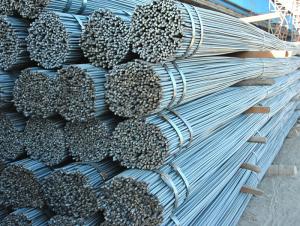Hot Rolled 12mm Steel Rod Price Steel Bar CNBM
- Loading Port:
- Tianjin
- Payment Terms:
- TT OR LC
- Min Order Qty:
- 334 m.t.
- Supply Capability:
- 2000000 m.t./month
OKorder Service Pledge
OKorder Financial Service
You Might Also Like
Description of steel round bar:
(1) Thickness of not more than 2MM sheet, efficient blanking die, punch die and pressure die etc.
(2) All kinds of scissors, inserts, woodworking blade.
(3) Thread rolling die and wear-resistant slider.
Festures of steel round bar:
4340 Forged Round Steel Bar
1.Dia 80-800mm Length:2000-13000mm or as required
2.Technique:Forged
3.Delivery Time:45 days
Specifications of steel round bar:
It is used in the manufacture of a higher strength and higher quenching and tempering section of the 35CrMo steel, like big locomotive traction gears, supercharger drive gear, rear axle, the connecting rod and the spring load greatly clip.
Round bar | Diameter(mm) | Length (mm) | |
10~800 | 2000~5800 | ||
plate/sheet | Thickness(mm) | Width (mm) | Length (mm) |
10~800 | 80~2300 | 2000~5800
|
Images of steel round bar:
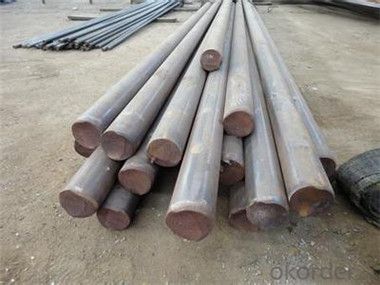
FAQ:
1. What is your package?
Packing situation: standard seaworthy packing or as customer required.
2. How long is the lead time?
Delivery time: 45 days after order confirmed.
3. What payment term do you accept?
Payment: T/T or L/C at sight.
- Q: What are the advantages of using nickel-chromium-molybdenum alloy steel round bars?
- Nickel-chromium-molybdenum alloy steel round bars offer numerous benefits: 1. Exceptional strength and durability: These round bars possess outstanding mechanical properties, including high tensile strength and hardness. As a result, they are ideal for applications that demand robust and long-lasting materials. 2. Enhanced resistance to corrosion: The inclusion of nickel and chromium in the alloy steel composition improves its ability to withstand corrosion. This makes it suitable for use in environments exposed to harsh chemicals or moisture. Consequently, the lifespan of these round bars is extended, reducing the need for frequent replacements. 3. Impressive heat resistance: Nickel-chromium-molybdenum alloy steel round bars can endure high temperatures without compromising their structural integrity. This makes them well-suited for applications involving extreme heat, such as the manufacturing of boilers, heat exchangers, and other heat-resistant equipment. 4. Versatility in fabrication: These round bars can be easily machined and fabricated, enabling the production of various shapes and sizes. This versatility makes them applicable across a wide range of industries, including aerospace, automotive, oil and gas, and construction. 5. Resistance to fatigue: The alloy composition of nickel-chromium-molybdenum steel enhances its resistance to fatigue, making it ideal for applications subjected to cyclic loading or repeated stress. This ensures that the round bars can withstand prolonged use without experiencing fatigue failure. 6. Excellent weldability: Nickel-chromium-molybdenum alloy steel round bars exhibit good weldability, facilitating easy joining or fabrication processes. This makes them suitable for applications that require welding or other forms of joining, providing flexibility in design and construction. In conclusion, the advantages of nickel-chromium-molybdenum alloy steel round bars make them a preferred choice in industries where strength, durability, corrosion resistance, heat resistance, versatility, fatigue resistance, and weldability are crucial factors for success.
- Q: Can steel round bars be coated?
- Indeed, it is possible to coat steel round bars. Coating them yields numerous advantages, such as enhanced resistance to corrosion, increased durability, and improved visual appeal. The most commonly utilized coatings for steel round bars encompass galvanized coatings, epoxy coatings, and powder coatings. Galvanized coatings encompass the application of a zinc layer onto the steel's surface, which provides exceptional protection against corrosion. Epoxy coatings, on the other hand, find common application in industrial settings due to their remarkable chemical resistance and ability to withstand harsh environments. Powder coatings, involving the electrostatic application of a dry powder, are then cured under heat to form a robust and protective layer. These coatings can be employed on steel round bars to safeguard against rust and other forms of corrosion, thereby rendering them suitable for a broad scope of applications across various industries, including construction, manufacturing, and automotive.
- Q: Can steel round bars be galvanized?
- Yes, steel round bars can be galvanized. Galvanizing is a process of coating steel with a layer of zinc to protect it from corrosion. This process is commonly used to increase the longevity and durability of steel products, including round bars.
- Q: Can steel round bars be used for making camshafts?
- Yes, steel round bars can be used for making camshafts. Steel is a commonly used material due to its strength, durability, and heat resistance properties, which are essential for camshaft applications. Additionally, steel round bars can be easily machined and shaped into the desired camshaft design.
- Q: Can steel round bars be used in the manufacturing of electrical components?
- Indeed, the utilization of steel round bars is feasible in the production of electrical components. The malleable nature of steel renders it a flexible material that endows exceptional vigor and robustness, thus rendering it apt for a plethora of applications, including the manufacturing of electrical components. Steel round bars can be employed as linkages, connectors, or supports in electrical devices and apparatus. Consequently, they impart stability, reinforcement, and shielding to the electrical components, guaranteeing their optimal operation and protracted lifespan. Furthermore, steel is easily machinable, weldable, and moldable, thereby enabling manufacturers to tailor the round bars to the specific requirements of the electrical components. Nevertheless, one must bear in mind that depending on the precise application and environment in which they are employed, steel round bars may necessitate appropriate insulation or coating to prevent any electrical conductivity or interference.
- Q: How do you determine the appropriate steel grade for a specific application?
- Determining the appropriate steel grade for a specific application requires a comprehensive understanding of the application's requirements and the properties of different steel grades. Here are some key steps to consider: 1. Identify the application requirements: Start by clearly defining the specific application's requirements such as load-bearing capacity, corrosion resistance, temperature resistance, and durability. Consider factors such as the environment the steel will be exposed to, the expected stress levels, and any specialized characteristics needed. 2. Research steel grades: Once the application requirements are understood, research various steel grades available in the market. Identify steel grades that are known for possessing the desired properties required for the specific application. Consult industry standards, expert opinions, and available resources to gain insights into different steel grades and their performance in similar applications. 3. Evaluate material properties: Analyze the physical, mechanical, and chemical properties of the steel grades under consideration. Key properties to assess include strength, ductility, toughness, hardness, corrosion resistance, weldability, and formability. Compare these properties with the application requirements to determine which steel grades align best with the specific needs. 4. Consider cost and availability: Evaluate the cost and availability of the steel grades that meet the application requirements. Factors such as the initial cost, maintenance costs, and availability of the steel grade in the required form and quantity should be taken into account. This step ensures that the chosen steel grade is not only suitable but also feasible from an economic perspective. 5. Seek expert advice: Consulting with experts, such as metallurgists or engineers, can provide valuable insights into selecting the appropriate steel grade. Their expertise and experience can help weigh the pros and cons of different steel grades, identify potential challenges, and suggest alternatives or modifications if necessary. 6. Conduct testing and trials: If feasible, conduct testing or trials using samples of the selected steel grade to assess its performance under real-world conditions. This step can help validate the suitability of the chosen steel grade and identify any unforeseen issues or areas for improvement. By carefully considering the application requirements, researching steel grades, evaluating material properties, considering cost and availability, seeking expert advice, and conducting testing and trials, one can effectively determine the appropriate steel grade for a specific application.
- Q: Can steel round bars be used in the manufacturing of power transmission components?
- Yes, steel round bars can be used in the manufacturing of power transmission components. Steel round bars are known for their high strength, durability, and ability to withstand heavy loads, making them suitable for various applications in power transmission. These components include gears, shafts, couplings, and other parts that need to transmit power efficiently and reliably.
- Q: How do steel round bars contribute to sustainable construction?
- Steel round bars contribute to sustainable construction in several ways. Firstly, steel is a highly durable and long-lasting material. Steel round bars are known for their strength and resilience, which allows them to withstand heavy loads and extreme weather conditions. This durability ensures that structures built with steel round bars have a longer lifespan, reducing the need for frequent repairs or replacements. This not only saves money but also reduces the environmental impact associated with the production and disposal of construction materials. Additionally, steel is a highly recyclable material. When a structure reaches the end of its life cycle, the steel round bars can be easily and efficiently recycled. This reduces the demand for virgin steel production, which is an energy-intensive and environmentally harmful process. Recycling steel also helps to reduce waste in landfills and conserve natural resources. Moreover, steel round bars can be prefabricated off-site, which offers several environmental benefits. Prefabrication allows for greater precision and efficiency in construction, reducing material waste and energy consumption. It also minimizes noise, dust, and pollution on-site, making construction projects more sustainable and less disruptive to the surrounding environment. Furthermore, steel round bars are often used in sustainable building designs. Steel structures can be designed to maximize natural light and ventilation, reducing the need for artificial lighting and air conditioning. This improves energy efficiency and reduces greenhouse gas emissions. Steel's versatility also allows for flexible and adaptable designs, facilitating future modifications and extensions without significant demolition or waste generation. Lastly, steel round bars are commonly used in the construction of green buildings and sustainable infrastructure. These structures are designed to minimize their environmental impact throughout their life cycle, from construction to operation and eventual decommissioning. Steel's attributes, such as its recyclability, durability, and energy efficiency, make it a preferred choice in sustainable construction practices. In conclusion, steel round bars contribute to sustainable construction by offering durability, recyclability, prefabrication opportunities, energy efficiency, and versatility. By using steel in construction projects, we can reduce waste, conserve resources, minimize environmental impact, and create structures that are built to last.
- Q: Can steel round bars be used in the manufacturing of office furniture?
- Yes, steel round bars can be used in the manufacturing of office furniture. They can be utilized for creating sturdy frames, legs, or supports for various office furniture pieces such as desks, chairs, shelves, and cabinets. The steel's durability and strength make it an ideal material choice for office furniture that needs to withstand heavy use and provide long-lasting stability.
- Q: What are the advantages of using precipitation-strengthened steel round bars?
- Using precipitation-strengthened steel round bars in various applications offers several benefits. Firstly, these bars possess improved mechanical properties, making them stronger and more durable compared to regular steel bars. Through the heat treatment process of precipitation hardening, fine particles form within the steel structure. These particles act as obstacles to dislocation movement, resulting in enhanced strength and hardness. Secondly, the increased strength of precipitation-strengthened steel round bars allows for material usage reduction while maintaining the desired level of structural integrity. This leads to cost savings in terms of raw materials and transportation, making it an economical choice in the construction and manufacturing industries. Additionally, precipitation-strengthened steel round bars exhibit excellent corrosion resistance properties. The formation of fine particles during precipitation hardening creates a dense and uniform microstructure, effectively blocking the movement of corrosive agents. This corrosion resistance makes these bars ideal for applications in harsh environments or industries where exposure to corrosive substances is common. Another advantage of using precipitation-strengthened steel round bars is their ability to withstand high temperatures. The fine particles within the steel structure contribute to improved thermal stability, enabling these bars to maintain their strength and hardness even under elevated temperatures. This makes them suitable for applications involving high-temperature operations, such as in the aerospace and automotive industries. Furthermore, precipitation-strengthened steel round bars possess superior fatigue resistance, making them advantageous in applications that require repetitive or cyclic loading. The precipitation hardening process enhances the material's resistance to fatigue failure, allowing it to withstand prolonged stress without significant deformation or failure. This makes these bars suitable for use in structures subjected to dynamic or fluctuating loads, such as bridges, cranes, and machinery components. In conclusion, precipitation-strengthened steel round bars offer enhanced mechanical properties, reduced material usage, excellent corrosion resistance, high-temperature stability, and superior fatigue resistance. These advantages make them the preferred choice for a wide range of applications, spanning from construction and manufacturing to the aerospace and automotive industries.
Send your message to us
Hot Rolled 12mm Steel Rod Price Steel Bar CNBM
- Loading Port:
- Tianjin
- Payment Terms:
- TT OR LC
- Min Order Qty:
- 334 m.t.
- Supply Capability:
- 2000000 m.t./month
OKorder Service Pledge
OKorder Financial Service
Similar products
Hot products
Hot Searches
Related keywords

